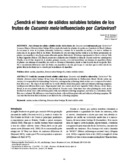| dc.contributor.author | Rodrígues, Sandra M.M. | |
| dc.contributor.author | Bleicher, Ervino | |
| dc.contributor.author | Nogueira, Sávio G. | |
| dc.date.accessioned | 2015-03-19T22:18:28Z | |
| dc.date.available | 2015-03-19T22:18:28Z | |
| dc.date.issued | 2006 | |
| dc.identifier | 471331 | es_ES |
| dc.identifier.issn | 1659-0082 | es_ES |
| dc.identifier.uri | https://repositorio.catie.ac.cr/handle/11554/6964 | |
| dc.description | 1 ilustración, 11 referencias | es_ES |
| dc.description.abstract | La mosca blanca (Bemisia tabaci biótipo B) ha estado afectando los plantíos de melón en el nordeste de Brasil. Además de succionar la savia de la planta, transmite Carlavirus, causante de la amarillez en melón, a la cual se atribuye la reducción de los grados Brix de los frutos. El objetivo de esta investigación fue verificar si los frutos provenientes de plantas con amarillez y sin ella presentan diferentes grados Brix totales. El trabajo experimental se llevó a cabo en Valle de Bajo Jaguaribe (Russas-CE), Brasil, en una área sembrada con el híbrido Acclaim de Cucumis melo var. cantalupensis Naudin. A los 63 días después de la siembra, primera cosecha, se recolectaron frutos sin síntomas de amarillez y frutos de plantas con síntomas de amarillez, los cuales se llevaron al laboratorio, donde se hizo la medición de los grados Brix.
No se encontraron diferencias entre los frutos con amarillez y sin ella, por lo que se concluye que la reducción de los grados Brix en los frutos no es causada por la incidencia de amarillez. | es_ES |
| dc.description.abstract | The whitefly (Bemisia tabaci biotype B) has been affecting melon production in Northeastern Brazil. Besides plant sap suction, it is responsible for transmitting Carlavirus, causing melon yellowing, which in this case is suspected to reduce fruit Brix scores. The object of our work was to verify whether fruits from plants with and without yellowing symptoms would present different Brix scores. Experimental work was carried out at Low Jaguaribe Valley (Russas, Ceará State), Brazil, in an area planted with the Acclaim hybrid of Cucumis melo. Sixty-three days after planting the seeds, in the first harvest, fruits were collected from plants with and without yellowing symptoms, and taken to a laboratory, where Brix was evaluated. No differences were found on fruits collected from plant with and without yellowing symptom. We
conclude that the fruit Brix reduction is not linked to the yellowing symptom. | en_EN |
| dc.format.mimetype | pdf | |
| dc.language.iso | es | es |
| dc.publisher | CATIE, Turrialba (Costa Rica) | es_ES |
| dc.relation.ispartof | Manejo Integrado de Plagas y Agroecología Número 77 (Abril 2006) | |
| dc.rights.uri | https://creativecommons.org/licenses/by-nc-nd/4.0/ | |
| dc.subject | CUCUMIS MELO | es_ES |
| dc.subject | BEMISIA TABACI | es_ES |
| dc.subject | VIRUS | es_ES |
| dc.subject | ENFERMEDADES DE LAS PLANTAS | es_ES |
| dc.subject | SINTOMAS | es_ES |
| dc.subject | PROPIEDADES ORGANOLEPTICAS | es_ES |
| dc.title | ¿Será el tenor de sólidos solubles totales de los frutos de Cucumis melo influenciado por Carlavirus? | es_ES |
| dc.title.alternative | Could the amount of total soluble solids from Cucumis melo fruit be affected by Carlavirus? | es_ES |
| dc.type | Artículo | es_ES |
| dc.journal.issueNumber | 77 | |
| dc.journal.pages | 86-88 | |



